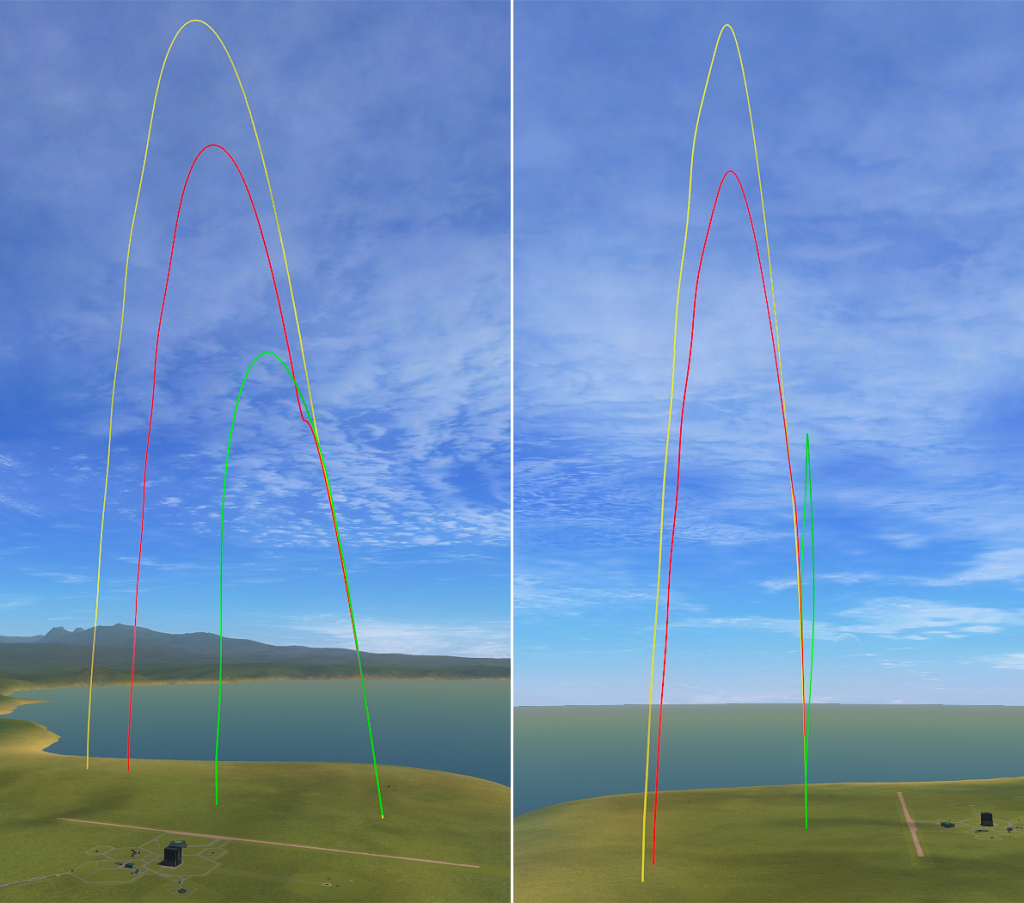 The main goal of the Progeny Mk2.1, our first multi-booster rocket, was to see what would happen to the apokee of the payload based on the timing of the second stage ignition. To do this we setup 3 launch profiles with ignition at early coast, late coast and plans for a mid-coast ignition time that would depend upon results of the first two launches. All three launches were successful and we have now analyzed all the data that was gathered.
The main goal of the Progeny Mk2.1, our first multi-booster rocket, was to see what would happen to the apokee of the payload based on the timing of the second stage ignition. To do this we setup 3 launch profiles with ignition at early coast, late coast and plans for a mid-coast ignition time that would depend upon results of the first two launches. All three launches were successful and we have now analyzed all the data that was gathered.

Telemetry data plot from Flight 1(1 pixel = 0.5s)
The first flight ignited its second-stage booster just prior to the burnout of the first stage. This was not only done as part of the overall plan discussed in the previous paragraph but to see if the first stage booster would explode due to the heat of the second stage ignition. The failure of the first stage booster to overheat and explode has made it clearer that the explosion from the Progeny Mk2 was caused mainly by the impact of the boosters. This first flight of the Mk2.1 reached an apokee of only 2.8km, which is hardly impressive considering the Progeny Mk1-A with its single booster reached an apokee of just over 2km. The early staging boosted the speed of the rocket so fast while it was low in the atmosphere the dynamic pressure was as high as 72kPa. The thicker air also caused much more tumble of the payload (seen in the scatter of the AoA plot on the graph at the top of the telemetry report) upon separation from the second booster, which increased drag and lowered the apokee.

Telemetry data plot from Flight 2 (1 pixel = 0.5s)
For the second flight we did the exact opposite of the first and waited until the rocket had lost nearly all its vertical velocity before triggering the second stage. This allowed it to coast higher up where the air is thinner and the engine efficiency is greater. As the telemetry plot shows this did make a big difference, reaching an apokee of 4.7km and the dynamic pressure was actually highest when the payload was falling back towards the ground, which was still nearly 2.5x less than the first launch. Being higher also led to a much smoother payload release, but the loss of vertical speed ultimately meant that the second stage could gain back only the velocity it lost during the coast period and barely add any. We knew there was more height to be had! An additional factor not shown in the telemetry is the pitch of the rocket (not to be confused with AoA), which gradually decreases the higher the rocket goes, especially while it is coasting. The longer we wait to fire the second stage the shallower the ascent becomes, which also lowers the apokee.
To decide when best to fire off the second stage we at first considered just cutting the coast time in half, which would be 10 seconds after first stage separation (+0:13). But given that the second flight almost equaled its max velocity after 20 seconds of coast, we decided that waiting half as long would still be too soon, so we took a closer look at the data and decided to ignite closer to where the velocity drop crosses the altitude gain, which was about 9 seconds prior to second stage ignition at +0:23. Ultimately we settled on +0:15 (12 seconds into the coast) to ignite the second booster.

Telemetry data plot from Flight 3 (1 pixel = 0.5s)
Following this launch profile, the third flight was indeed the highest, topping out at 5.9km. We were surprised when looking at the telemetry plot to see how close the ignition came to the mass of the rocket. We don’t have enough data yet to say whether that is a coincidence or correlation, and it’s something we will look to answer with the Progeny Mk3. The dynamic pressure was highest during the second stage boost, but still came nowhere near the amount of pressure seen in the first flight while under boost. Although the payload was released higher the faster speed caused a bit more tumble as it was let free of the second stage. The second stage also did not climb higher than the payload as it had on previous flights, with the air too thin for its fins to act like a propeller.
In conclusion, the timing of the second booster wasn’t as simple as igniting at the beginning or end of the coast. Our next rocket, the Progeny Mk3, will explore the intricacies of coast periods more in the first quarter of 2017.








